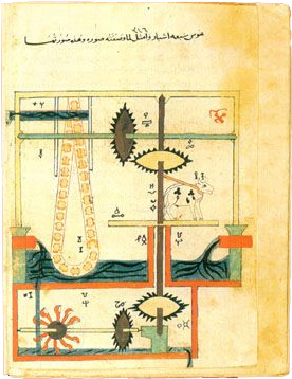
This week's opening of the impressive Museum of Islamic Art in Doha, Qatar, has got a whole lot of press attention, with write-ups in the New York Times, Economist and elsewhere. The articles describe how the museum, paid for by the oil wealth of Qatar's ruling family, is housed in an elegant building designed by Chinese-born architect I.M. Pei, and contains a huge collection of exquisite art exhibits, from silk wall hangings to jade jewellery.
But they've all missed what I think is the most exciting exhibit of all: a manuscript by an 11th-century Andalusian engineer called al-Muradi. It is tantalisingly called The Book of Secrets about the Result of Thought, and it doesn't disappoint. In it, al-Muradi describes (and draws) more than 30 machines and devices, including war machines, calendars, the earliest Arabic description of water clocks, and complex mechanical figures called automata. His rugged clocks were driven by fast-moving streams and involved elaborate gear systems, sometimes lubricated by mercury - a feature not seen in Europe until the 13th century. Some included epicyclic gearing, in which small wheels are carried around on larger wheels. This is the earliest known description of such complex gearing apart from the Antikythera mechanism; this is a technique the Arabs may have learned from the Greeks, and then built on (for this reason al-Muradi gets a walk-on mention in Decoding the Heavens).
The Book of Secrets is normally held in the Biblioteca Medicea Laurenziana in Florence, but the Italians have lent it to the Qatar museum for a temporary exhibition that lasts until 22 February 2009. The manuscript has been badly defaced, but researchers at Leonardo L3 have spent months studying it using imaging techniques that they have developed to decode Renaissance manuscripts, and have read much more of the Book than has been possible before. They have produced an interactive digital version of the manuscript that is also being displayed in Qatar, along with physical models of two of al-Muradi's machines: The Clock with Three Characters and the excellently-named Fortress Demolisher.
According to Qatar newspaper The Peninsula, other scientific and mathematical manuscripts from the 11th to 15th centuries are also on display in Doha. Scholars from the Islamic world have been responsible for some fundamental scientific and technological advances, as well as preserving much ancient Greek knowledge that would otherwise have been lost. This is too little recognised, and I'm so pleased that the Qatar museum is showcasing Islamic science and technology as well as art.
PS I couldn't find any pictures from the Book of Secrets, so instead here's a picture of a water pump from The Book of Knowledge of Ingenious Mechanical Devices, written by the engineer al-Jazari in 1206.